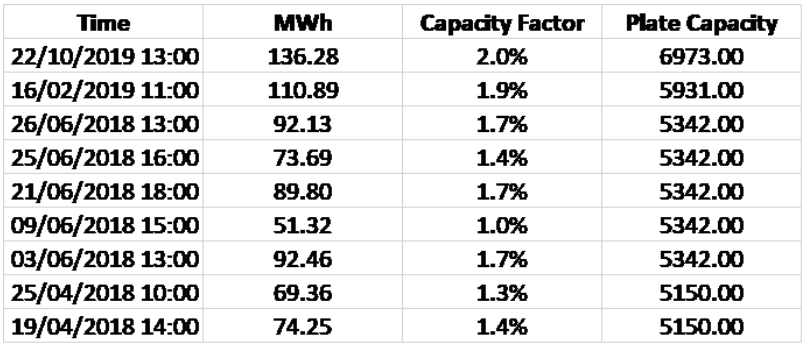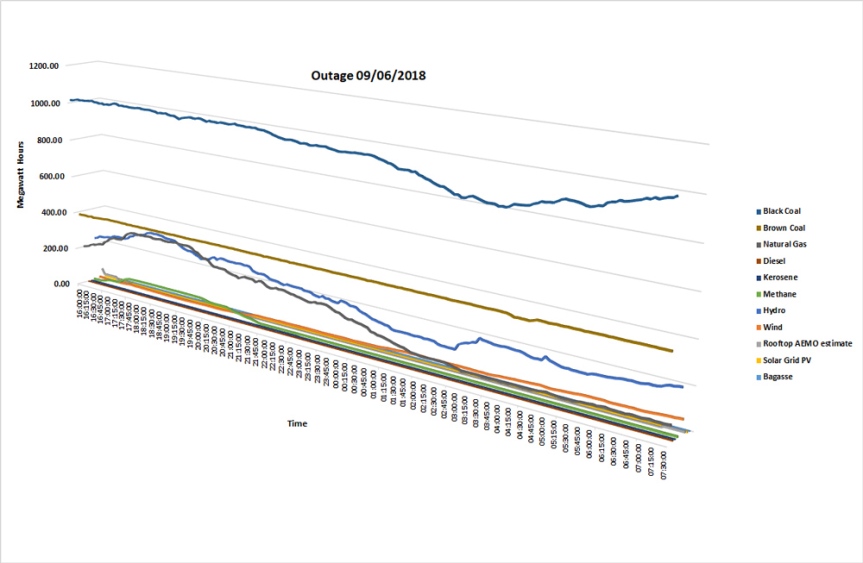It takes a special brand of delusion to still believe that chaotically intermittent wind and solar can replace conventional generators, such as coal, gas and nuclear plants. But they’re still out there. Indeed, some of them hold high, elected office. Or once did.
Maths, physics, economics and meteorology are not difficult disciplines. But mastery thereof requires the ability to grapple with some pretty harsh realities. Especially when you’re claiming that it’s possible to run a first world economy entirely on sunshine and breezes.
Without the need to consult a PhD in any of those fields, it’s pretty safe to conclude that calm weather is a thing, as is the fact that the sun drops over the horizon, every single day. Oh yeah, and clouds are real, too.
But the true zealot retorts that all these issues will be readily solved with storage – stirring reference is usually made to giant lithium-ion batteries or, at a pinch, pumped hydro.
Those wedded to the existence of any such solution are bound to ignore the laws of physics and economics, not to mention logic and reason.
Mike O’Ceirin has evidently had to contend with characters who exhibit all of the traits outlined above. Mike provides a punchy little list of facts that show precisely why unreliable wind and solar will never replace conventional generation sources.
Just do it! Replace coal with RE. Why not?
Catallaxy Files
Mike O’Ceirin
3 May 2020
How often have you heard that? I have heard it many times from people in various walks of life but principally from environmental activists. They speak as if this is a simple thing to do and we only need the will to do it. When the reliability is put forward as a problem they say we just need enough storage.
Will storage work? How much do we need? That depends on the amount of variability and how do we measure that? A useful tool for this is the Capacity Factor that is calculated on an hourly basis as a fraction of the energy dispatched in the hour compared with the theoretical maximum (the plated or installed capacity) on the grid.
Looking at the whole of 2018 the average Capacity Factor of the wind supply was 29% based on the maximum plate capacity connected to the eastern grid (5342 MW) and the hourly average of 1549MW of dispatched wind power.
In a system where continuity of supply is a critical consideration we need to look at the variability and not just the average. Could the capacity approach zero? What do we find using a figure of 2% that is just about zero?
The AEMO data for 2018 and 2019 shows that it happened nine times in the last two years and there are many more instances over the last seven years.
The figures are for five-minute intervals. So for a period at 1pm on October 29 last year the whole wind fleet contributed 136MW compared with the average of 1950MW for the year.
At the time there were 55 wind power stations spread from Queensland to Tasmania and South Australia. This is an exceptionally large area and a large investment in wind infrastructure but only 136 MWh could be dispatched! When considered along with the performance of other sources this is even more significant as the chart below demonstrates.
This shows a particular outage, any will do and the one selected is 09/06/2018. The chart covers 16 hours starting at 4pm. Clearly black coal and brown coal dominate with gas and hydro ramping up to meet the evening peak.
Over the period a total of 344 GWh of power was delivered and RE supplied 49 GWh. Hydro is usually regarded as a form of RE and that provided 42 GWh with wind and solar tipping in 7 GWh. There was even a period of three hours when there was no electricity from wind and solar. The other providers and barely visible.
The only reliable form of RE at the moment is hydroelectricity as the chart shows but we have not built any new dams for many decades, principally because of pressure from environmentalists. They don’t like dams and the foundation of the Greens party was the activist effort to stop the building of the Franklin in Tasmania. While this environmentalist thinking is in force hydroelectricity does not have a future.
If you ask the environmentalists they will tell you that the spells when there is little or no wind and solar can be overcome by storage. You know, batteries and pumped hydro!
Many think that large grid scale batteries will do the trick, like the one in South Australia, is that possible? The findings of this outage can be applied to a hypothetical wind power station, of 200 MW. Over 16 hours, operating at the average capacity of 29% that would generate 928 MWh. Compare that with the capacity of the 150MW Tesla battery, it is not in the race to bridge the gap. And that is for a single wind farm. Sure, it might be useful for other things like charging with cheap electricity and selling it at a premium price (“ getting our money back!”), but it certainly it is not going to decrease the price of electricity. Or maintain continuity of supply
So, will the proposed Snowy Mountains 2.0 have enough capacity?
Computer modelling indicates that could just about work to stabilise the current wind power station infrastructure There are many ifs and buts in the model but let’s say it all works. The result would be a renewable energy supply to replace one 2 GW coal-fired power station. Cost about $21 billion and all the wind turbines to be replaced every 15 years or so at a cost of about $16 billion. Who thinks that will happen and that the current infrastructure will be expanded so that fossil fuels are replaced? Just find the sites and the money to build nine more Snowy 2.0s to follow the first!
The data to support this article comes from the AEMO, it publishes in five minute increments the amount of energy dispatched to the eastern grid from all the generators attached to it. Each wind farm is counted as a unit and the multiple generators in the coal-fired power stations are counted individually.
Catallaxy Files





Reblogged this on uwerolandgross.
Reblogged this on ajmarciniak.